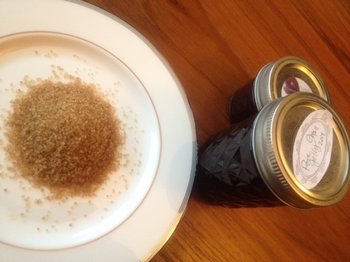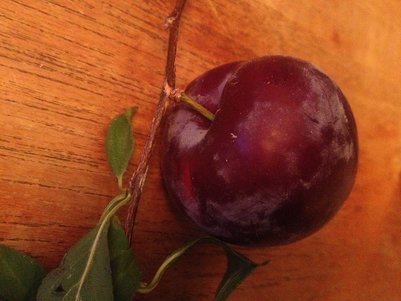 Warm. Rich. And what a set! These are my first impressions after a recent experiment with turbinado sugar. I'd been curious about turbinado -- raw cane sugar -- since Gillian Helquist told me she used it in her marmalade at Nick's Cove. I'd been mulling her comment about avoiding turbinado when she wanted a clean, bright flavor... I wondered what it would do for the pomegranate juice I'd squeezed. The juice was typical pomegranate: thin and tart and deep purple, with a swirl of ultra fine pulp. I decided to try making a small batch, just four jars, and see what there was to see. First, let me tell you that pomegranate jelly is pure joy to make in tiny batches like this. The juice blended with the pectin with little coaxing and came to a boil within minutes. I've been getting a little neurotic with my "boiling." I bring the mixture to 212 degrees and that's how I avoid over-boiling. Then I added the turbinado and held my breath as the thick brown grains danced through the pomegranate-pectin mixture and settled to the bottom. Within a few moments, the turbinado had dissolved and the mixture was starting to come to a boil again. When it came to a full rolling boil, I set my timer for three minutes. Rarely does the Ball recipe (which calls for boiling one minute after adding sugar) hold true on my stove. To my surprise, the jelly was sheeting off the spoon in just under two minutes. I gave it an extra minute of heat and then shuffled the jelly into my hot jars. Splashdown in the boiling water bath for ten minutes, and done! The next morning, I came running down the stairs like it was Christmas, eager to try my new jelly recipe. I was thrilled! The set was lightly firm, not glassy, and the flavor was deep and fruity. I could taste the pomegranate! Here's my recipe (I tweaked the recipe from the Ball Blue Book, in case you want to see the original): Pomegranate Turbinado Jelly Ingredients: 1 3/4 cup pomegranate juice 3 tablespoons Ball Flex Batch Classic Pectin Mix (Also known as RealFruit Classic Pectin) 2 1/2 cups turbinado sugar (I have also tried this recipe with 1 3/4 cups of turbinado sugar and have been pleased with the pomegranate flavor that shines through.) Method: Sterilize jars and keep hot. Warm lids and bands in simmering water until ready to use. Prepare water bath and bring to boil. 1. Juice pomegranates to make 1 3/4 cups. Strain through fine sieve and a layer of cheese cloth if necessary. 2. Combine pomegranate juice and pectin in saucepot (medium size is fine for this small batch). Bring to boil over medium heat, stirring constantly. 3. Add turbinado sugar. It may clump up at first, but this sugar dissolves quickly, so keep an eye on it. Return to a rolling boil and boil for one minute. Pull your spoon through the mixture, testing for set; it will sheet from the spoon quickly. 4. Remove from heat. Pour hot jelly into hot jars, leaving 1/4 inch head space. Cover with lids and bands. 5. Process jars in boiling water bath for 10 minutes. Remove from water and let cool.
0 Comments
I heard about macerating (essentially marinating fruit in sugar) from Meryl Natchez of Dactyls & Drakes. It was several years ago... we met for lunch and Meryl gave me a giant box of strawberries for jam. As we munched our salads, I lamented that so many recipes in books and online required huge amounts of sugar. Sometimes, it seemed all I was tasting was the sugar!
"You could macerate the fruit for a day, and that way you could use less sugar," Meryl suggested. Hmm. The advice was tempting, but not precise enough for my literal brain. What did "less sugar" mean? How would I know how much sugar to use? And when Meryl said "macerate the fruit for a day," did she mean a full 24 hours? Tinkering in the kitchen Flash forward to Summer 2015. I have discovered the magic of maceration and there's no going back. It started when I received a gift of about 20 pounds of Blenheim apricots. I like to experiment when I have such an excess of fruit. I made a traditional batch, and then I decided to macerate a few quarts of chopped 'cots. It was easy: I just cut up the apricots and poured the same amount of sugar the recipe called for onto the fruit. I added the lemon juice, too. Then I mixed it all up and put it in the refrigerator until the next day. Perhaps I was imagining things, but it seemed the fruit turned jammy and set up faster after a day of stewing in sugar and lemon juice. The flavor was bright and sweet and the color was vibrant. But I hadn't used less sugar. So, I tried again. The second time, I used a low sugar recipe and macerated the fruit for one day. I wasn't crazy about the second batch. It was ok, but I wasn't in love. I thought it needed a touch more sugar. Three's a charm I tried a third time. This time, I added a bit more sugar to the recipe and macerated the fruit for two days. Bingo! I'd found the right sugar-to-fruit ratio to please my palette, and it was substantially less than I had been using for the last several years. In my view, using less sugar and macerating the fruit makes the flavor stand out more. The sugar does it's job of breaking down the fruit and the reduced amount of sugar lets that flavor shine through. And, I am convinced that macerating helps the fruit set up better and faster. Keep in mind, I have only macerated stone fruits so far. I'll try other fruit and let you know!  With canning, you're always learning. This summer, I was the student and pectin was the teacher. It all started when I learned from three different sources (all very reliable) that you should use slightly under-ripe fruit for jam and jelly making. Slightly under-ripe fruit has higher pectin levels than fruit at its peak or over-ripe. For years, I had sought perfectly ripe fruit, and wasn't opposed to using fruit that was slightly dinged here and there -- I'd just cut those bruised pieces out. I think the "dinged fruit is fine fruit" theory was widespread -- even farmers would set aside these slightly imperfect fruits just for home canners at the farmers markets and charge a few cents less. You're going to cut it up, pour a bunch of sugar on it and cook the heck out of it, so it doesn't need it to be perfect, right? WRONG! I decided to conduct an experiment. I sliced and diced 5 cups of slightly under-ripe plums with the skin on (there's plenty of pectin in fruit skins, seeds and pits) and made my jam according to a Ball Blue Book recipe. The jam did its normal thing, but it seemed to set up faster -- took me by surprise! Before I knew it, my jam was sitting up straight on a spoon. When I opened my tester jar the next morning to have a taste, the knife didn't move through the jam as easily as I like it to. This jam was tasty and tart, but definitely FIRM! (I prefer a softer set, but have friends and family who like firm jam.) I still had loads of slightly under-ripe plums, so for the next batch, I peeled about half of the plums. The result was a nicely set up, but not too firm, batch of plum jam. My theory: If I was going to use fruit that had a higher level of pectin, I needed to remove some of the peel to get the texture I prefer. One of my sources at the UC Davis Department of Plant Sciences, Diane Beckles, pointed out that canners might have to make a trade-off between pectin content and sugar levels. Slightly under-ripe fruit may not be as sweet -- it depends on the fruit. There is a lot to consider when you're choosing your fruit! And, now it makes sense when I see tips that suggest using 3/4 firm-ripe and 1/4 under-ripe fruit in your recipes. (Not that you always have a choice when in comes to ratios of firm-ripe and under-ripe. This seems like splitting hairs, even to me.) I'll continue to mix it up and document the results, and of course, share with all of you! |
The more you can, the more you can can.I started The Hot Ping a few years ago and took a break for a bit, but people have said they liked it, dare I say missed it, so I am re-posting a few of my previous Pings. And I hope to keep posting about home canning... it truly is a never-ending adventure. ArchivesCategories |
 RSS Feed
RSS Feed